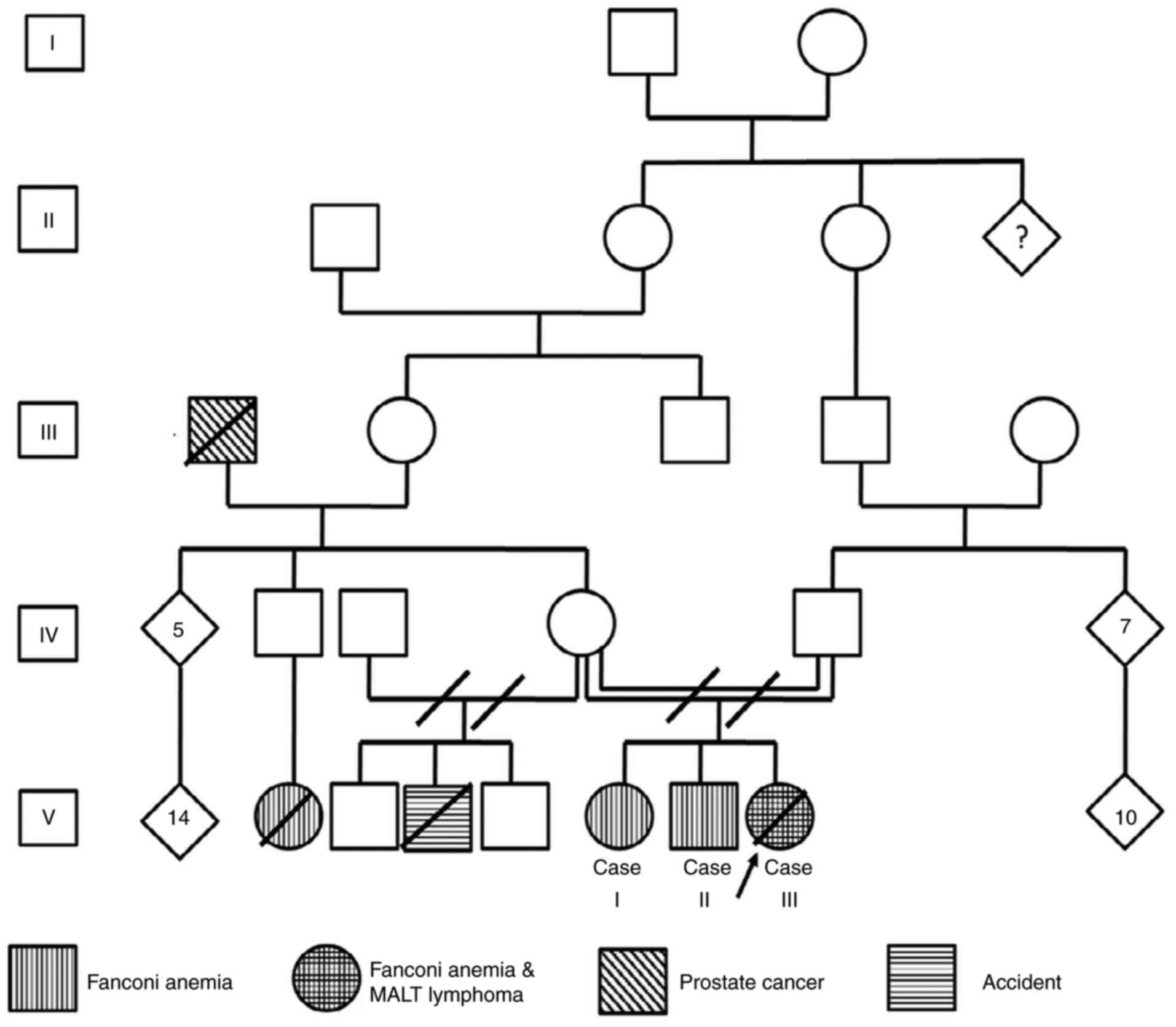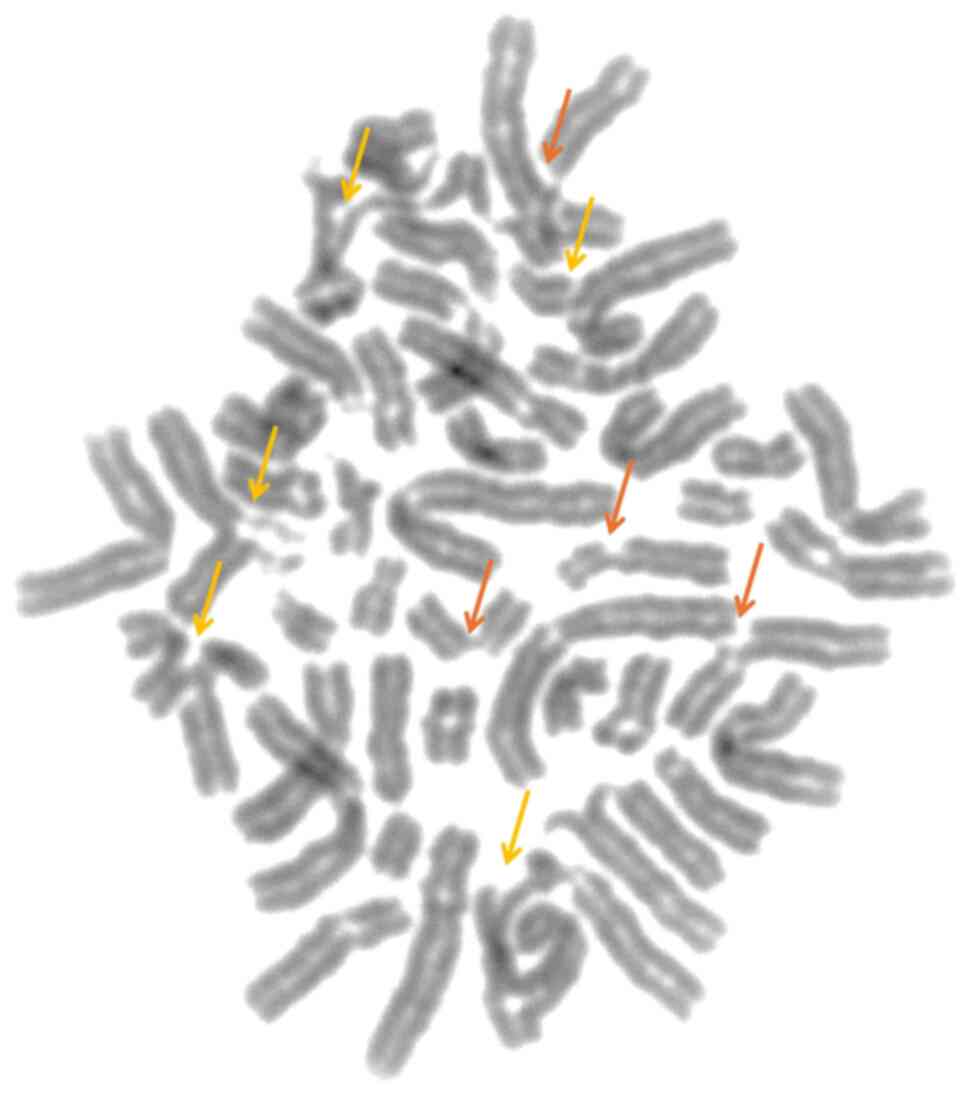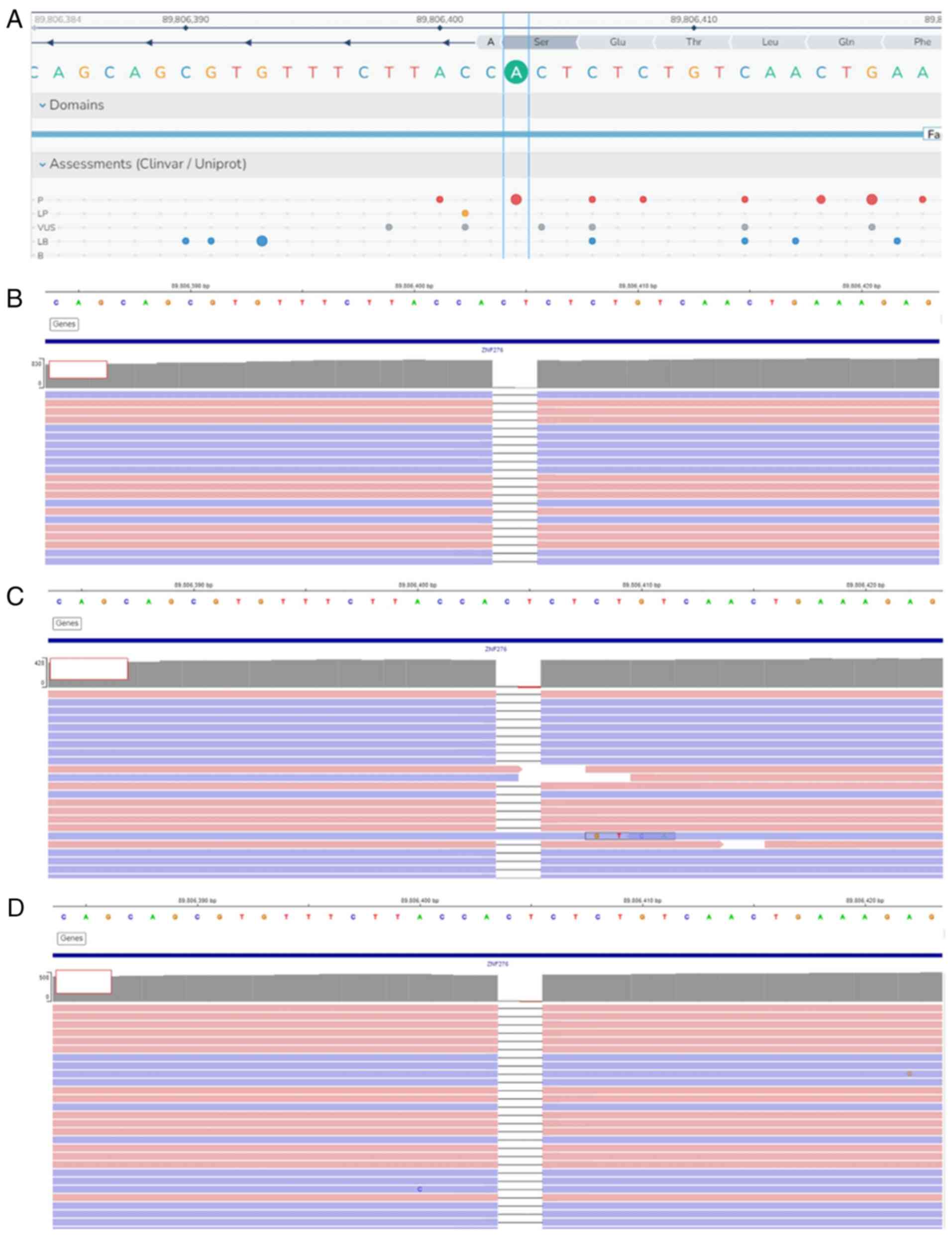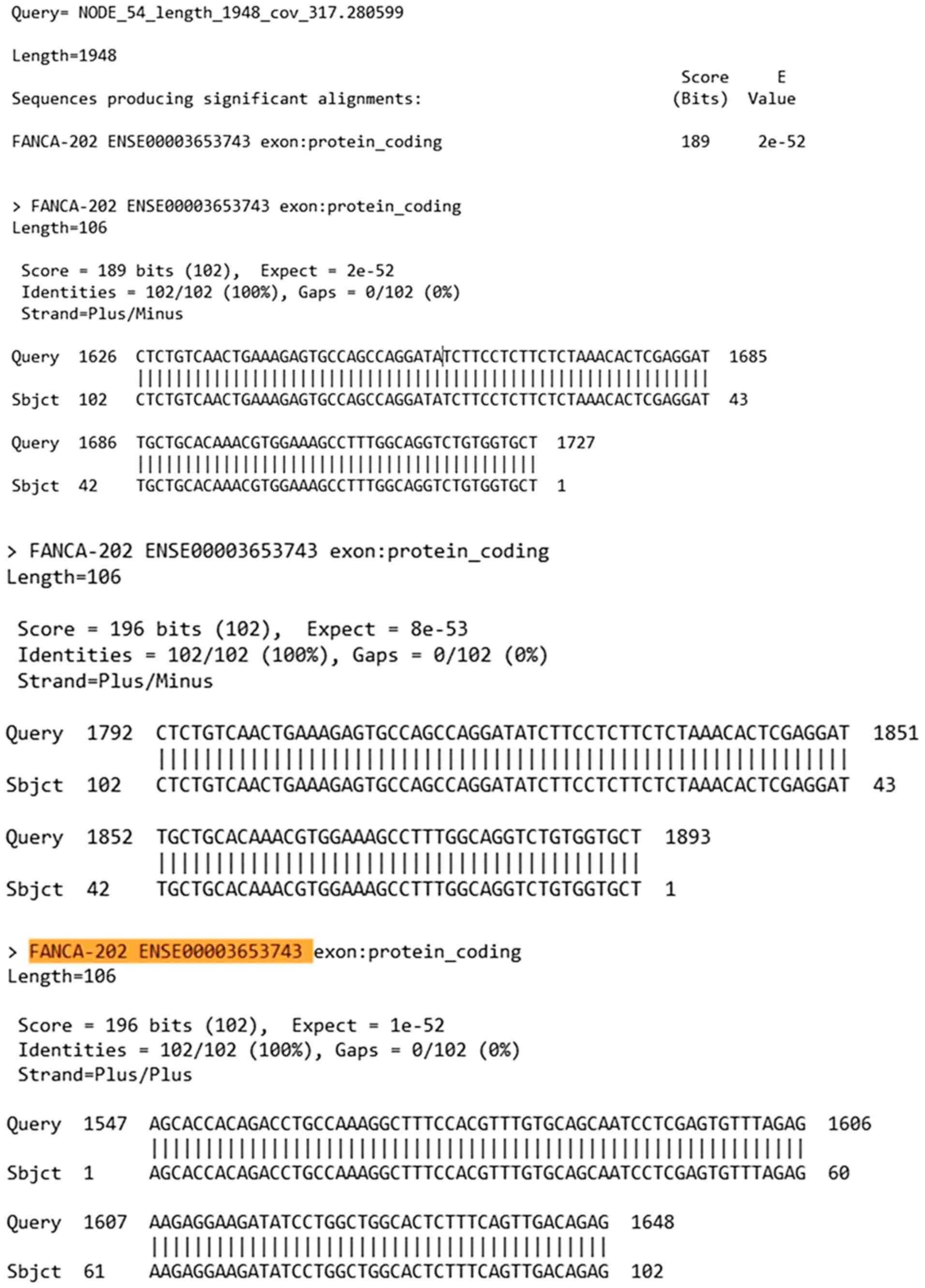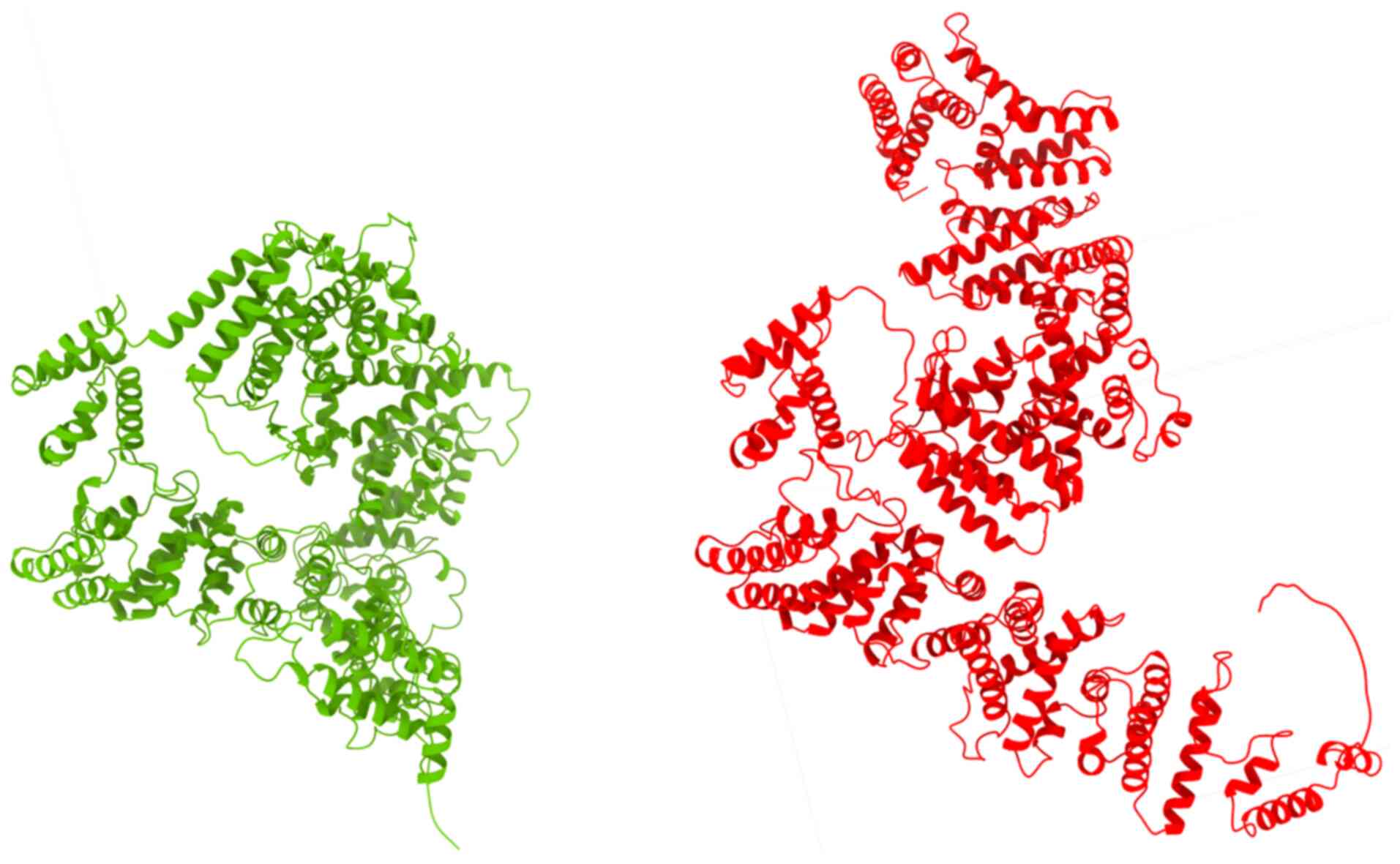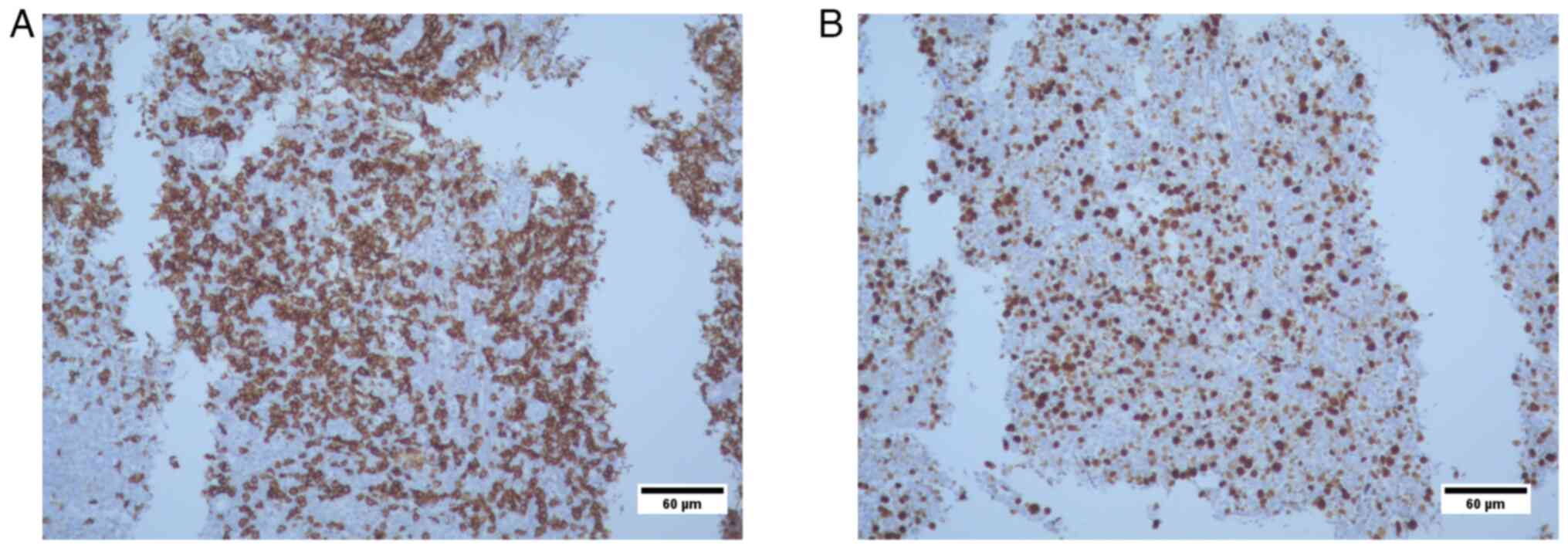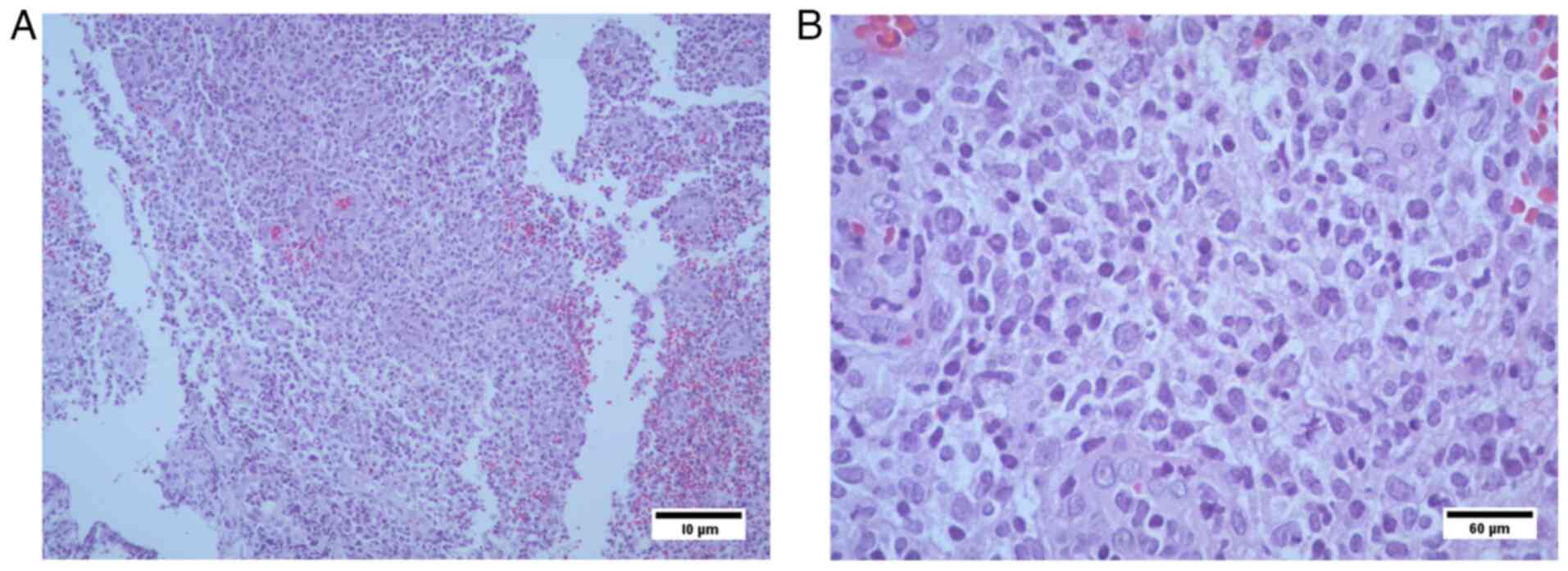Unveiling a pathogenic FANCA gene variant in a Mexican family with Fanconi anemia through next‑generation sequencing
- Authors:
- Published online on: January 9, 2025 https://doi.org/10.3892/etm.2025.12798
- Article Number: 48
-
Copyright: © Cuero-Quezada et al. This is an open access article distributed under the terms of Creative Commons Attribution License.
Abstract
Introduction
Fanconi anemia (FA) is a genetic instability syndrome that increases the risk of cancer, bone marrow failure and congenital anomalies. It is the most common type of hereditary bone marrow failure worldwide, with an estimated population incidence of 1 in 5,000,000 (1,2).
This disease is caused by an alteration in one of the 23 FA complementation group A (FANCA) genes associated with the FA/BRCA repair pathway, responsible for 60-70% of all mutations. Inefficient DNA damage repair creates genomic instability, which promotes the development and spread of cancer; within these DNA repair mechanisms are the genes involved in the FA/BRCA pathway (3). This pathway repairs interstrand crosslinks (ICL), endogenously created by reactive oxygen species, or exogenously by exposure to ICL-inducing agents. It is crucial for the ICL to be remediated, since they covalently join opposite DNA strands to block both replication and transcription (4). If the damage cannot be repaired, it leads to massive apoptosis that generates bone marrow failure and leads to an increased risk of developing certain types of malignancies, such as acute myeloid leukemia or squamous cell carcinoma of the head and neck (5,6).
In addition to the previously mentioned cancers, FA has been associated with a predisposition to other types of neoplasms. Mutations within the FA/BRCA repair pathway have been shown to be associated with a predisposition to breast, uterine, prostate and liver cancer, due to alterations in FANCC and FANCD1 (7), or as a late onset after treatment with immunosuppressive chemotherapy for aplastic anemia (8).
This disease is diagnosed based on clinical suspicion and a chromosome breakage test, and molecular confirmation allows variants to be detected. In the case of FANCA, 40% of variants can be detected using multiplex ligation-dependent probe amplification. In addition, next-generation sequencing (NGS) provides a detection capacity of ≤90% of all variants (7). Nucleotide variations, small insertions/deletions and large deletions are the most common causes of mutations in FANCA (9).
The current study aims to present a pathogenic variant in FANCA, which was detected by NGS and was observed in three Mexican siblings diagnosed with FA.
Materials and methods
Clinical and hematological report
The current study presents the case of a family diagnosed with FA; the pedigree had an endogamic ancestry (Fig. 1). In total, 3 of 3 children were diagnosed with FA and 1 of them developed a suggestive mucosa-assisted lymphoid tissue (MALT) lymphoma during childhood. Written informed consent was obtained from all 3 children, who are of legal age, and from the father of the deceased patient.
Case 1: The patient, who was 21 years old at the time of writing, presented with clinical criteria compatible with FA. The patient developed pancytopenia at 13 years of age. Chromosomal breakage tests were performed with diepoxybutane and the result was positive. The features found in this patient are listed in Table I.
Case 2: The patient, who was 19 years old at the time of writing, had epistaxis since birth until 5 years of age, with a clinical suspicion of familiar thrombocytopenic purpura; however, the patient was diagnosed with bone marrow failure at 11 years of age, alongside positive chromosomal breakage test results. The patient's features are provided in Table I.
Case 3: The patient, who was a female deceased at 12 years of age, had developed epistaxis and ecchymosis in the lower limbs from birth until 6 years of age, and was diagnosed with thrombocytopenic purpura vs. megaloblastic anemia. At 9 years of age, the patient was subjected to a chromosomal breakage diagnostic test with diepoxybutane, which revealed bone marrow failure. The clinical manifestations are shown in Table I. At 11 years of age (March 2018), the patient presented at the Hospital Civil de Guadalajara ‘Dr Juan I. Menchaca’ (Guadalajara, Mexico) with abdominal pain, hyporexia and difficulty swallowing. Gastric endoscopy revealed digestive tract bleeding associated with chronic gastritis but not with Helicobacter pylori. Endoscopic colon biopsies were subjected to hematoxylin and eosin staining performed according to standard procedures, with the use of a Primo Star 1 microscope (Carl Zeiss AG).
Sample preparation
Two samples of peripheral blood (PB) (heparin and EDTA) were obtained from each patient. The first sample underwent a karyotype and chromosomal breakage test using standard procedures according to Bobabilla-Morales et al (10), while the second sample was used for DNA extraction using a QIAamp® DNA Blood Mini kit (Qiagen GmbH) according to the manufacturer's instructions.
Cytogenetics analysis and chromosome breakage test
Conventional karyotype analysis was performed from PB. In brief, the PB were incubated for 72 h in Gibco RPMI 1640 medium (Thermo Fisher Scientific, Inc.), supplemented with glutamine, fetal bovine serum and antibiotics (Gibco; Thermo Fisher Scientific, Inc.). Next, Giemsa-Trypsin- Wright (GTW) banding was performed according to standard procedures (11). The chromosomes were analyzed and karyotyped following the International System for Human Cytogenetic Nomenclature (12).
For the chromosome breakage assay, PB samples were cultured and treated with mitomycin c (Sigma Aldrich; Merck KGaA) at a concentration of 50 ng/ml, and in certain cases with 0.1 µg/ml diepoxybutane (Sigma-Aldrich; Merck KGaA), for 72 h at 37˚C. For each sample, 100 metaphases were analyzed to calculate the mean number of chromosomal aberrations and the percentage of aberrant cells. Scoring of chromosomal aberrations was performed according to Bobabilla-Morales et al (10). The diagnosis of AF was positive if ≥15% of cells possessed aberrant metaphases.
Cultures of blood samples collected from healthy individuals were used in parallel as negative controls, healthy patients were recruited from the outpatient clinic and were invited to participate, the procedure to be performed was explained to them as indicated in the informed consent form, and once they signed it, the PB sample was taken.
Nucleic acid extraction
Genomic DNA was isolated from bone marrow using the QIAamp® DNA Blood Mini kit (Qiagen GmbH) according to the manufacturer's instructions. The DNA concentration was determined using ultraviolet light spectrophotometry, with the absorbance (A) at 260 nm (A260) measured, while its purity was assessed by reading the A230 and A280, resulting in values of 1.8 and 2.1 for A260/A280 and A260/A230, respectively, according to the results obtained with the NanoDrop™ One (NanoDrop Technologies; Thermo Fisher Scientific, Inc.).
NGS
Genetic DNA analysis was performed using a targeted sequencing panel designed for germline cancer hereditary-associated mutations [panel size: 403 kb, 113 genes (covering all exons), 125 SNPs (48 ID SNPs and 77 SNPs for polygenic risk score), 10,341 oligo probes (TruSight Hereditary Cancer Panel; Illumina, Inc.)]. The libraries were prepared using Illumina DNA Prep with Enrichment library prep chemistry, which combines library preparation and enrichment processes. The analysis enables the detection of single-nucleotide variants, insertions/deletions and copy-number variants in a single assay. Assay quality data were evaluated using the BaseSpace Enrichment App v3.1.0 (Illumina, Inc.). Analysis was performed in Franklyn on the Genoox platform (https://franklin.genoox.com/clinical-db/home) and results were reported following the recommendations of the Human Genome Variation Society (HGVS) Nomenclature 2016 based on the human assembly GRCh37 (also known as hg19) (https://www.ncbi.nlm.nih.gov/datasets/genome/GCF_000001405.13/).
Bioinformatic analysis
The FASTQ files obtained were evaluated with FastQC software to analyze the quality of the sequences, which revealed sufficient quality of the sequences without evident problems.
Next, the sequences were assembled using SPAdeS (http://bioinf.spbau.ru/spades) with Burrows-Wheeler Aligner assembly parameters to correct errors in the sequences before performing the assembly ‘spades.py-1 R1.fastq-2 R2.fastq careful’. The obtained assembly was saved in the file ‘contigs.fasta’, which was used to perform variant analysis. The quality of the obtained assembly was sufficient and met the expected metrics (Table II).
Once the assembly was obtained, alignment analysis was conducted with BLAST software using the following parameters: ‘blastn-query contigs.fasta-subject fanca.fasta-dbtype nucl-out blast_results.txt’.
In silico predictive analysis was performed using MutationTaster software (https://www.genecascade.org/MutationTaster2021/), which predicts the effect of a variant in the protein encoded by a gene.
Upon in silico predictive analysis, molecular modeling of the FANCA variant was performed by using the Biopython library (13) to translate the nucleotide sequence into an amino acid sequence. Subsequently, the amino acid sequence files were stored in ‘.fasta’ format for further use. Next, the AlphaFold Protein Structure Database (https://alphafold.ebi.ac.uk) was used to model the structure of the protein encoded by the FANCA gene with the variant reported against the reference protein.
Immunohistochemical analysis
Tissue had been paraffin-embedded for 12 h at room temperature and the thickness of sections was 3 µm. For dewaxing, the slides with the samples were placed in xylene at 60˚C for 16 h and subsequently, the slides were subjected to two consecutive washes with xylene for 10 min each. The slides were then washed in ethanol at 70, 80 and 100% for 2 min each. Subsequently, the samples were processed in a steamer with citrate buffer for 15 min. The blocking reagent used was IntelliPATH FLX Peroxidase Blocking Reagent (cat. no. IPB5000; Biocare Medical), applied for 5 min at room temperature. The CD20 antibody (cat. no. CM 004; Biocare Medical) at a dilution of 1:100 at 36˚C for 16 min, the CD3 antibody (cat. no. ACI 3170; Biocare Medical) at a dilution of 1:100 at 36˚C for 15 min and the Ki67 antibody (cat. no. CRM 325; Biocare Medical) at a dilution of 1:50 at 36˚C for 32 min were applied; the ultraView Universal DAB Detection Kit (cat. no. 760-500; Roche Tissue Diagnostics; Roche Diagnostics, Ltd.) was used to detect the primary antibodies according to the manufacturer's instruction. Visualization and observation were carried out under a Primo Star 1 light microscope (Carl Zeiss AG).
Results
Cytogenetics and chromosome breakage analyses
Chromosomal breakage analysis was performed in three pediatric patients with clinical suspicion of FA. The chromosomal breakage test was positive, indicating an increased number of chromosomal rearrangements (mean, 4.2 breaks/cell; Fig. 2), compared with the control subjects (non-FA, mean, 0.2 breaks/cell). The chromosomal breakage test confirmed the diagnosis of FA in all three siblings. Cytogenetic analysis showed a normal karyotype.
NGS
NGS analysis showed that all three siblings had a homozygous deletion of two base pairs in FANCA. The FANCA:c.3931_3932delAG (p.S1311*) variant is shown in Fig. 3.
Bioinformatic analysis of the pathogenic variant c.3931_3932delAG found in FANCA. Once the alignment analysis was conducted with BLAST software, the results compared based on the FANCA reference sequence (NM_000135.4) yielded the outcomes shown in Fig. 4.
The variant present in the patients was of a deleterious type and was predicted to affect the protein encoded by the FANCA gene, causing a pronounced change in the protein sequence. Since the variant caused a frameshift in the protein sequence, this led to a change in the amino acid sequence, which may cause a nonsense-mediated mRNA decay in the protein.
After molecular modeling of the FANCA:c.3931_393232delAG variant was performed by using the Biopython library (13), the AlphaFold Protein Structure Database was used to model the structure of the protein encoded by the FANCA gene with the variant reported against the reference protein (Fig. 5). In the AlphaFold- generated three-dimensional structure, a significant conformational alteration in the protein was observed. This structural change led to a profound functional impairment of the protein, resulting in, among other effects, nonsense-mediated mRNA decay.
Histopathological analysis
The results revealed i) lymphocyte infiltration due to lymphoproliferative lesion (transverse colon biopsies); presence of CD20-positive tumor cells; and CD3 reactivity, which was suggestive of a MALT type non-Hodgkin lymphoma; and ii) Ki67 positivity in 70% of tumor cell nuclei. At 12 years of age, the patient succumbed to bone marrow failure, non-Hodgkin lymphoma progression, severe febrile neutropenia and acute respiratory failure. Immunohistochemical analysis of the transverse colon biopsy from Case 3 showed CD20+ tumor cells, CD3 reactivity and 70% KI67+ nuclei in tumor cells (Figs. 6 and 7). The results were suggestive of non-Hodkin MALT lymphoma.
Discussion
To date, 2,065 variants in the FANCA gene have been reported, of which 688 have been described only once according to the Fanconi Anemia Mutation Database (14). It has been demonstrated that selecting an appropriate method of detection is fundamental to identify new findings (7).
FANC genes became relevant to the occurrence of cancer in the general population when bi-allelic mutations in the breast and ovarian cancer susceptibility genes BRCA1 (FANCS), PALB2 (FANCN) and BRCA2 (FANCD1) were identified in patients with FA, as germline monoallelic mutations or promoter hypermethylation of FA genes in patients without FA confer an increased risk of developing multiple cancer types, since the canonical function of FA proteins is to collaborate with other DNA repair proteins to eliminate chromosomal breaks in DNA ICLs. Similarly, in a genomic analysis of nine common cancer types from The Cancer Genome Atlas, FA genes were altered in 40% of tumors, with the majority belonging to the FA/BRCA pathway (3). FANCA is a gene that creates a multi-functional protein that participates in the FA/BRCA pathway, which repairs ICLs and performs homologous recombination and nucleotide excision repair in coordination with other genes.
The present study describes three siblings diagnosed with FA, as confirmed not only by their clinical manifestations but also by chromosomal breakage tests. The NGS TruSight Hereditary Cancer Panel was used to identify changes in the FANC genes available in this panel. All three patients had the variant FANCA:c.3931_3932delAG in a homozygous state. This variant has been reported in a single patient in a study on Japanese patients with FA (15). Another study carried out by Zhu et al (16) that had reported the variant was a study on hereditary breast cancer. It is known that certain pathogenic variants in breast cancer are located in the FANC genes, since they belong to the FA/BRCA pathway (16). The current bioinformatic analysis and the results of Franklin by Genoox indicated that this variant had a pathogenic classification (17). Since the variant caused a frameshift in the protein sequence, it was predicted that the variant present in the aforementioned patients could have a deleterious effect on the protein encoded by the FANCA gene, resulting in a pronounced change in the protein sequence. This change in the amino acid sequence may lead to a nonsense-mediated mRNA decay in the protein.
Although the histopathological findings were initially suggestive of MALT lymphoma, the diagnosis remained inconclusive due to insufficient tissue for further characterization. Therefore, other differential diagnoses, including alternative lymphoma subtypes, could not be excluded. The literature has reported only two cases of FA and lymphoma. The first one describes a 30-month-old male patient who was diagnosed with T-cell lymphoblastic lymphoma, presented high sensitivity to cytotoxic chemotherapy and was diagnosed with FA. In addition to t(11;14)(p13;q32), cytogenetic analysis showed chromosomal instability with chromosomal breaks, as well as radial figures (18). The second report in the literature describes a male patient who, at 5 years of age, was diagnosed with FA. At 11 years of age, the patient underwent a bone marrow transplant, and only 1 year later, the patient's clinical data were suggestive of lymphoma. The biopsy indicated T-cell lymphoblastic lymphoma and human leukocyte antigen analysis revealed tumorigenic cells derived from the same patient (19). To the best of our knowledge, no reports on chemotherapy for lymphoid tumors in patients with FA exist in the literature. In total, 30-40% of all extranodal lymphomas are primary gastric lymphoma (PGL), which is the most prevalent extranodal location of non-Hodgkin lymphoma. Furthermore, it accounts for 4-20% of all non-Hodgkin lymphoma and ~5% of primary gastric neoplasm cases. The two most common types of PGL based on histology are marginal zone B-cell lymphoma of MALT and diffuse large B-cell lymphoma. The highest incidence of MALT lymphoma occurs in individuals aged 50-60 years (20).
FANCA is considered hypermutable and polymorphic (21). The FANCA variant is responsible for causing FA; however, it is not considered to be able to cause MALT lymphoma in Case 3, since the literature does not refer to any association between this type of lymphoma and the FANC genes.
In conclusion, the present study reported a variant in FANCA, which was determined by NGS in three siblings diagnosed with FA. The detected variant, FANCA:c.3931_3932delAG, was classified as pathogenic by bioinformatic analysis.
Acknowledgements
Not applicable.
Funding
Funding: No funding was received.
Availability of data and materials
The datasets used are publicly available at the National Center for Biotechnology Information (NCBI), the BioProject accession no. is PRJNA1169362 (https://www.ncbi.nlm.nih.gov/sra/PRJNA1169362); the Sequence Read Archive (SRA) (https://www.ncbi.nlm.nih.gov/sra) accession nos. of each of the samples are SRX26297315, SRX26297314 and SRX26297313. All other data may be requested from the corresponding author.
Authors' contributions
Conceptualization, LBM, SABJ, ICQ and ACR; methodology, SABJ, ICQ and FAFL; clinical management of the cases, as well as the follow-up and evaluation of the patient's progress, MMOS and JRCR; bioinformatic analysis, LJZ; histopathological analysis, FDJBR; writing-original draft preparation, ICQ and FAFL; writing, review and editing, ACR; supervision, LBM. LBM, SABJ and ICQ checked and confirm the authenticity of all the raw data. All authors have read and agreed to the final version of the manuscript.
Ethics approval and consent to participate
The study was conducted in accordance with the Declaration of Helsinki and approved by the Institutional Ethics Committee of the Hospital Civil de Guadalajara ‘Dr. Juan I. Menchaca’. Written informed consent and assent were obtained from the patients and their parents for participation in this study and genetic testing. Healthy control blood donors provided written informed consent to their blood being used for scientific experimentation.
Patient consent for publication
Written informed consent was obtained from the patients and their parents to publish the present study.
Competing interests
The authors declare that they have no competing interests.
References
|
Fiesco-Roa MO, Giri N, McReynolds LJ, Best AF and Alter BP: Genotype-phenotype associations in Fanconi anemia: A literature review. Blood Rev. 37(100589)2019.PubMed/NCBI View Article : Google Scholar | |
|
Molina B, Frías S and Ramos S: Anemia de Fanconi, Parte 1. Diagnóstico citogenético. Acta Pediatr. Méx. 43:102–128. 2022. | |
|
Niraj J, Färkkilä A and D'Andrea AD: The Fanconi anemia pathway in cancer. Annu Rev Cancer Biol. 3:457–478. 2019.PubMed/NCBI View Article : Google Scholar | |
|
García-de-Teresa B, Rodríguez A and Frias S: Chromosome instability in Fanconi anemia: From breaks to phenotypic consequences. Genes (Basel). 11(1528)2020.PubMed/NCBI View Article : Google Scholar | |
|
Lach FP, Singh S, Rickman KA, Ruiz PD, Noonan RJ, Hymes KB, DeLacure MD and Kennedy JA: Esophageal cancer as initial presentation of Fanconi anemia in patients with a hypomorphic FANCA variant. Cold Spring Harb Mol Case Stud. 6(a005595)2020.PubMed/NCBI View Article : Google Scholar | |
|
Repczynska A, Pastorczak A, Babol-Pokora K, Skalska-Sadowska J, Drozniewska M, Mlynarski W and Haus O: Novel FANCA mutation in the first fully-diagnosed patient with Fanconi anemia in Polish population-case report. Mol Cytogenet. 13(33)2020.PubMed/NCBI View Article : Google Scholar | |
|
Joshi G, Arthur NBJ, Geetha TS, Datari PVR, Modak K, Roy D, Chaudhury AD, Sundaraganesan P, Priyanka S, Na F, et al: Comprehensive laboratory diagnosis of Fanconi anaemia: Comparison of cellular and molecular analysis. J Med Genet. 60:801–809. 2023.PubMed/NCBI View Article : Google Scholar | |
|
Colović M, Todorović M, Colović N, Terzic T, Karadzic K and Jurišić V: Appearance of estrogen positive bilateral breast carcinoma with HER2 gene amplification in a patient with aplastic anemia. Pol J Pathol. 65:66–69. 2014.PubMed/NCBI View Article : Google Scholar | |
|
Kimble DC, Lach FP, Gregg SQ, Donovan FX, Flynn EK, Kamat A, Young A, Vemulapalli M and Thomas JW: A comprehensive approach to identification of pathogenic FANCA variants in Fanconi anemia patients and their families. Hum Mutat. 39:237–254. 2018.PubMed/NCBI View Article : Google Scholar | |
|
Bobabilla-Morales L, Corona-Rivera A, Corona-Rivera JR, Buenrostro C, García-Cobián TA, Corona-Rivera E, Cantú-Garza JM and García-Cruz D: Chromosome instability induced in vitro with mitomycin C in five Seckel syndrome patients. Am J Med Genet A. 123A:148–152. 2003.PubMed/NCBI View Article : Google Scholar | |
|
Lawce HJ and Brown MG: Cytogenetics: An overview. In: The AGT Cytogenetics Laboratory Manual. John Wiley & Sons, Inc., Hoboken NJ, pp25-85, 2017. | |
|
McGowan-Jordan J, Hastings RJ and Moore S (eds): ISCN 2020-An International System for Human Cytogenomic Nomenclature. Basel, Switzerland: Karger Publishers, 2020. | |
|
Cock PJ, Antao T, Chang JT, Chapman BA, Cox CJ, Dalke A, Friedberg I, Hamelryck T, Kauff F, Wilczynski B and de Hoon MJ: Biopython: Freely available Python tools for computational molecular biology and bioinformatics. Bioinformatics. 25:1422–1423. 2009.PubMed/NCBI View Article : Google Scholar | |
|
LOVD v.3.0: The next generation in gene variant databases. Retrieved April 25, Lovd, NL, 2024. Available from: https://www.lovd.nl/3.0/home. | |
|
Mori M, Hira A, Yoshida K, Muramatsu H, Okuno Y, Shiraishi Y, Anmae M, Yasuda J, Tadaka S, Kinoshita K, et al: Pathogenic mutations identified by a multimodality approach in 117 Japanese Fanconi anemia patients. Haematologica. 104:1962–1973. 2019.PubMed/NCBI View Article : Google Scholar | |
|
Zhu QY, Li PC, Zhu YF, Pan JN, Wang R, Li XL, Ye WW, Ding XW, Wang XJ and Cao WM: A comprehensive analysis of Fanconi anemia genes in Chinese patients with high-risk hereditary breast cancer. J Cancer Res Clin Oncol. 149:14303–14313. 2023.PubMed/NCBI View Article : Google Scholar | |
|
Richards S, Aziz N, Bale S, Bick D, Das S, Gastier-Foster J, Grody WW, Hegde M, Lyon E, Spector E, et al: Standards and guidelines for the interpretation of sequence variants: A joint consensus recommendation of the American college of medical genetics and genomics and the association for molecular pathology. Genet Med. 17:405–424. 2015.PubMed/NCBI View Article : Google Scholar | |
|
Goldsby RE, Perkins SL, Virshup DM, Brothman AR and Bruggers CS: Lymphoblastic lymphoma and excessive toxicity from chemotherapy: An unusual presentation for Fanconi anemia. J Pediatr Hematol Oncol. 21:240–143. 1999.PubMed/NCBI View Article : Google Scholar | |
|
Suzuki D, Kobayashi R, Yasuda K, Nakagawa A, Morimoto T, Yabe M, Yabe H and Kobayashi K: Precursor-T lymphoblastic lymphoma after unrelated bone marrow transplantation in a patient with Fanconi anemia. J Pediatr Hematol Oncol. 33:22–24. 2011.PubMed/NCBI View Article : Google Scholar | |
|
Violeta Filip P, Cuciureanu D, Sorina Diaconu L, Maria Vladareanu A and Silvia Pop C: MALT lymphoma: Epidemiology, clinical diagnosis and treatment. J Med Life. 11:187–193. 2018.PubMed/NCBI View Article : Google Scholar | |
|
Shahid M and Firasat S: FANCA and contribution of studies from Asian populations to the understanding of fanca mediated Fanconi anemia. Genetika. 51:1197–1225. 2019. |



